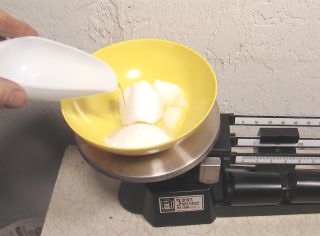
|
Here I have weighed out a colorful little bowl, added
50 grams KNO3, 25 grams sugar, and 12 grams Karo syrup. I am in the
process of pouring 50g water, which should be 50ml, right? Right.
|
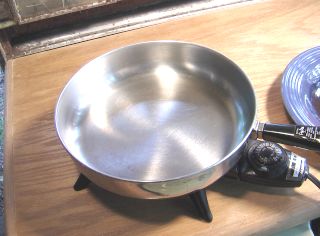
|
The electric skillet is out on the porch table. It's
really the top of an old stove that served kitchen duty for 15 years or so,
until it got promoted to porch duty. It is non-functional now, but
is holding up this section of countertop rather nicely.
|

|
The burner ring is here. Photo so you know why
the propellant makes a brown ring there as it cooks.
|
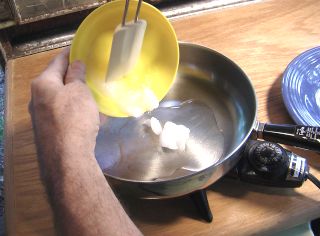
|
Wet stuff is scraped into the pan
|
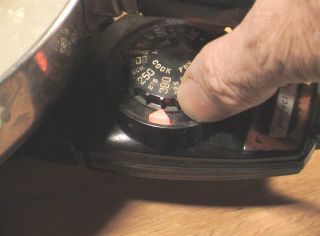
|
Temperature is set at 300 degrees F
|
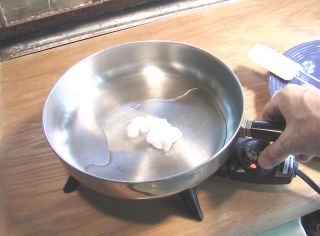
|
|
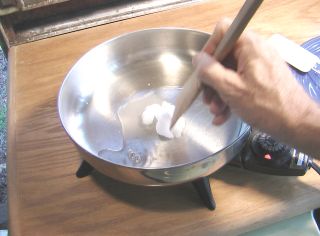
|
Big chunks are broken up with spatula
|
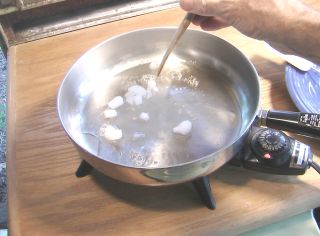
|
Little chunks are broken up with spatula.
|
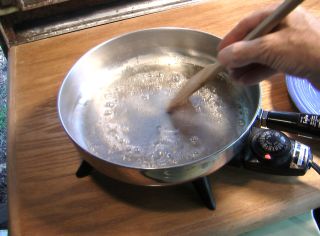
|
Bubbles are broken up with spatula. Now this is getting crazy. I like those bubbles. Leave them alone!
|
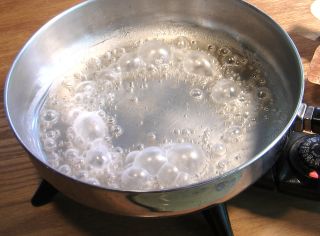
|
Mix is allowed to cook until bubbles stop forming and become solid.
|
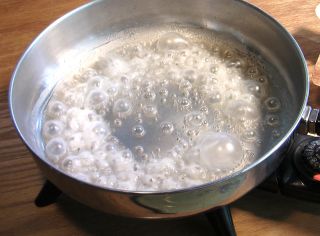
|
|
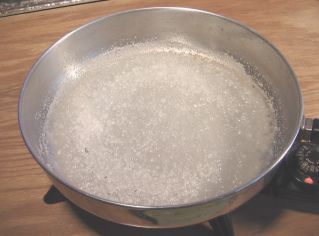
|
The
bubbling has ceased, most of the water is gone, but not all of it. The
surface is now damp but solid. Since the water is being heated underneath,
the surface is beginning to pop, throwing little flakes of propellant around
the pan and sometimes out of it. Drastic action is required to keep
most of the propellant in the pan.
|
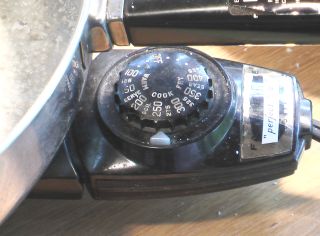
|
First, the temperature is reduced to 250 degrees F.
This is all that is really required, as there is no popping
and spattering at this lower temperature.
It will finish drying at this temperature, which does not degrade the propellant quickly.
|
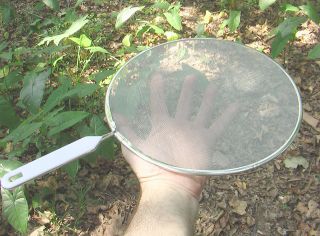
|
Next, it is covered with a "spatter guard." We use these here in Florida
to keep the bugs out of the collard greens. Also recommended when frying
bacon in the nude. (Apologies
for any disturbing images that might have occurred in relation to that comment.
Please envision the supermodel of your choice, not me.)
|
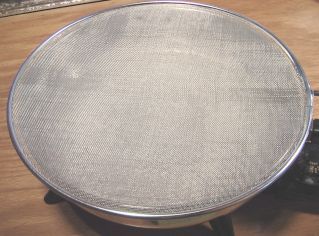
|
|
|
|
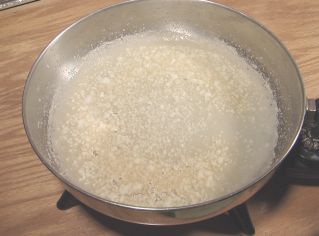
|
After an hour, the propellant seems dryish, and has turned brownish over the heating element ring. Time for a test!
|
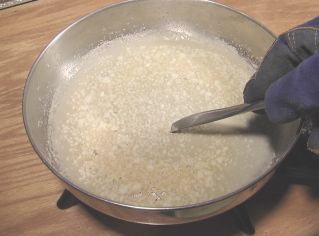
|
A small amount is removed from mid-pan, cooled for a few seconds, and rolled into a ball.
|
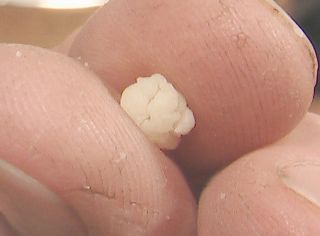
|
Or at least attempted... This stuff is too dry.
The flakes do not want to adhere to one another. It needs water!
|
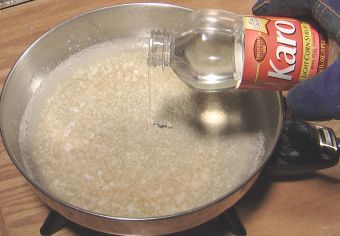
|
Water is supplied in the form of Karo Syrup, just a drop or two. It is easy to overdo this, so I pour carefully. About 1/4 teaspoon was added, maybe a little more.
|
|
|
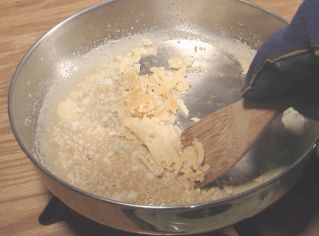
|
The temperature is increased to 300 degrees for about
3 minutes, to get the flakes good and hot. It may darken a tad during
this heating, that's OK.
A wooden spatula is used to scrape up the flakes and mix in the recently-added Karo Syrup evenly.
|

|
The flakes are pressed with the back of the spatula
to mash them together. A good bit of mashing and kneading is required
to get this propellant to its proper texture. (For large oven batches I use a food-processor. Small batches like these are easily done by hand.)
If it refuses to stick to itself, there are two solutions: heat and moisture.
Try heat first. Let it heat back up for a minute or two, and try kneading again.
If that doesn't work, add another drop or two of water or Karo, and knead.
|
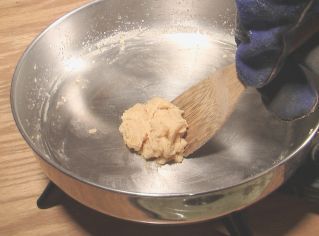
|
Finally,
it is all consolidated into a ball. It should have a texture resembling
modeling clay, or perhaps a little "creamier" at this temperature.
|
|
|
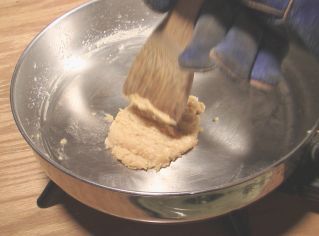
|
Flatten the propellant wad by chopping at it with
the spatula. This will spread it out so that it contacts the pan better.
That way it will reheat much faster and more evenly.
Reduce the temperature to 200 degrees F. Let the propellant cool for perhaps 10 minutes, and test it for texture.
If it is stiff and crumbly at 200 degrees, it needs more moisture. So
heat it up until soft, add a few drops of Karo or water, and knead again.
|

|
Notice how the propellant mass is a different shape
each time? If I were Betty Crocker, I might employ a "food stylist"
to get more uniform photos. But every time I knead this mass, it changes
shape, right? So please do not be disturbed by the multiplicity of
forms this propellant takes from photo to photo, it's moldability is one
of its charms.
|
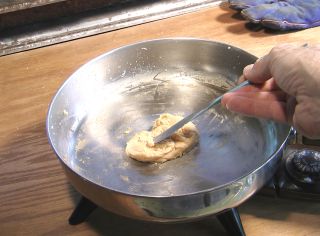
|
So now I think I have it right. It is pliable
at 200 degrees, although still a little bit stiff. The snap test may
be irrelevant, but I will try it anyway.
|
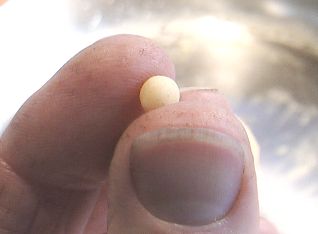
|
This time, it rolls into a ball rather nicely.
|

|
And it is easily mashed into a disc.
|

|
|

|
|
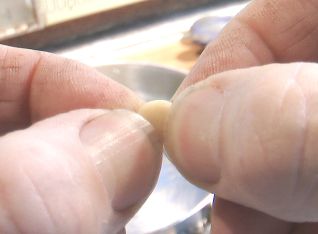
|
After a minute's rest on this cool, dry plate, I bend it to see if it flexes or breaks.
|
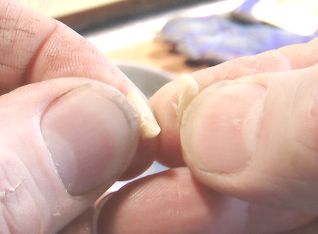
|
It breaks! Snap test is passed! This batch
will become rock-hard when cooled. In fact, it could stand to have
another drop or two of moisture, but that's OK - it will work.
Click Here for a video of a snap test (925k .wmv file, 8 seconds of uninspiring video)
|

|
Next
test: Burn rate at 1 atmosphere. This is more to determine the
ignitability of the propellant than anything else, as the burn rate will
be accelerated dramatically when burning at high pressure in the motor.
A gram or so is taken from the pan and rolled into a little stick exactly 1 inch long and about 1/4 inch diameter.
It is easier to roll these little sticks on a cloth-covered surface, such
as a firm mouse pad. I have a little board covered with denim for this
purpose.... somewhere. Guess I should find it. Or make another
one. It is just a cut-off jeans leg with a piece of 1x6 pine stuck
in it. Works great.
|
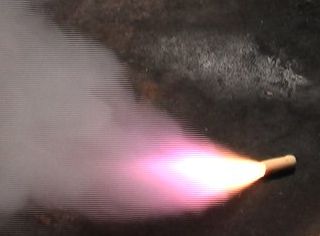
|
The strand is laid on a metal pan
and ignited with a torch. Usually, I use a stopwatch to time the burn,
but since this one is being caught on video I didn't bother.
The burn is timed from the instant of ignition to the instant of burnout.
This strand burned for 12 seconds, indicating good ignitability. Click Here for a video of this burn test. (1 meg .wmv file, 14 seconds of fire and smoke.)
Faster-burning rcandy is easier to ignite. Slow-burning propellant
burns just fine once the case comes up to pressure, but it takes a little
longer for it to get there.
But slower burning rcandy is a little slower burning in a motor too. Tthe
difference is reduced when it burns under pressure, but it is still there.
|
Putting it away
|
|
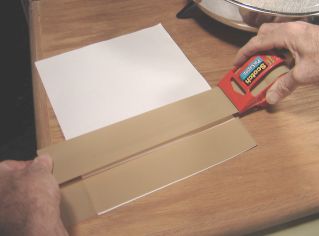
|
All
good things must come to an end. And on weeknights, they come to an
end all too soon. I have a full schedule in the morning so I can't
do any more wacky experiments, so I must put the propellant away. Fortunately,
I have a fun technique for doing so.
Mold liner is made
by sticking wide plastic mailing tape onto a sheet of copy paper. Clear
plastic tape works fine too, but the brown stuff is easier to see in these
photos. Cooled propellat will not adhere to this plastic. This
allows the cooled propellant to be removed from the mold. Later, it
can be removed from the liner without a struggle.
|
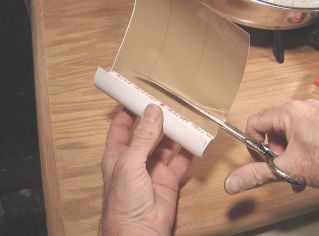
|
You
can barely see the mold. It's a section of PVC tubing, 3/4 inch diameter
and about 5-inches long, just big enough to hold this small batch of propellant.
To
get the right length of mold liner, I roll it around the outside of the tube,
and cut it off just a bit short. That way it will encircle the inside
with a little overlap.
The taped paper is rolled up and inserted into the PVC tube.
Sometimes it is hard to roll this taped paper up without creasing it. I
often use a smaller dowel as a form to roll it around, which makes it easy
to insert.
|
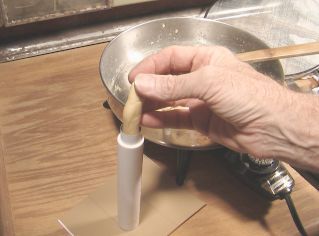
|
I chop off a chunk of warm, soft propellant, roll it into a stubby snake, and drop it into the lined tube.
A dowel is used to press it down, making room for the next stubby snake.
This is repeated until the propellant is all in the tube or the tube is full, whichever comes first.
|
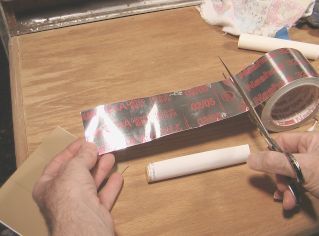
|
For long-term storage, I find the aluminum-foil duct
tape an ideal sealer.
Here I cut a section about three inches longer than the
propellant slug, which is now cool and has been removed from the PVC mold.
Note that
the taped-paper liner is stays on the propellant. That will make it
much easier to unpack later on, as well as giving it a bit more moisture
barrier.
|
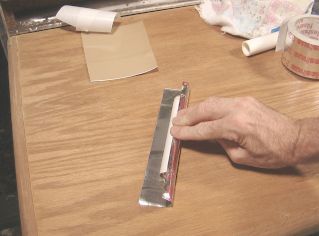
|
The backing is peeled off the tape, and the propellant
slug rolled up inside it. Then the open tape ends are mashed flat and rolled over to
seal out air.
Packages like this can keep indefinately.
|
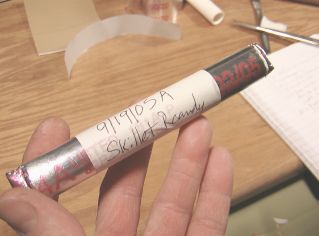
|
I make a point of labeling each package immediately.
Of course I know what it is now. But give me 15 minutes, and
some doubt will creep in. Give me a week and I will not have a clue.
Labels and records are a fine form of external memory. Masking
tape makes a good label.
|







































